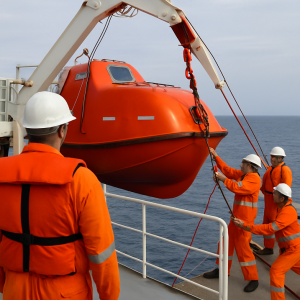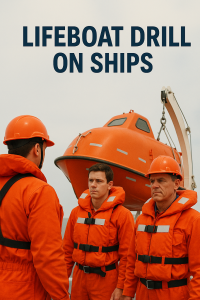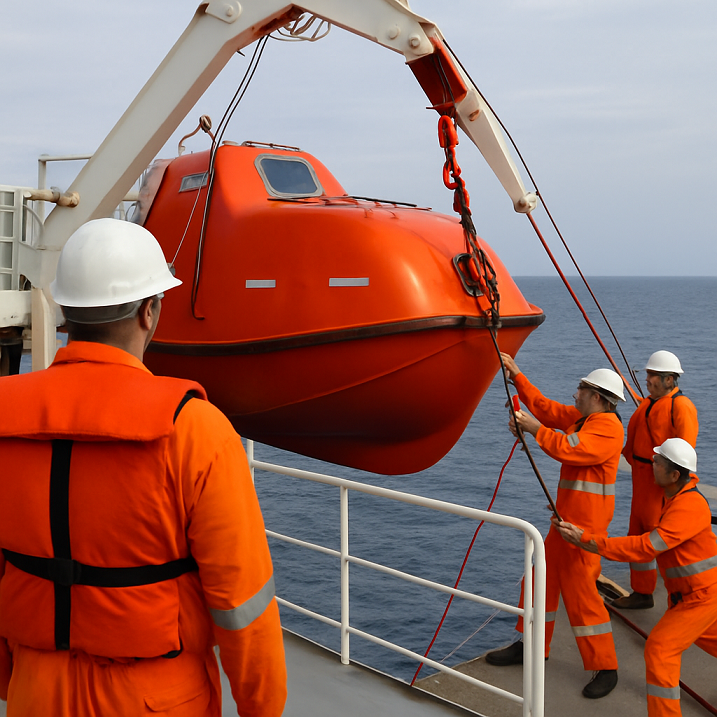Lifeboat drills are a vital safety measure onboard ships, mandated by SOLAS regulations. This guide explores compliance requirements, recent updates, and real-world practices to ensure crew preparedness in maritime emergencies.

Lifeboats, Legislation, and Lives at Sea
In the unforgiving world of maritime operations, preparedness is not optional—it’s the only buffer between crisis and catastrophe. Lifeboat drills, often viewed as routine tasks, are in fact a cornerstone of maritime safety. When executed correctly, they save lives. When neglected, the consequences can be fatal.
Maritime casualties investigated by agencies like the Marine Accident Investigation Branch (MAIB) and Paris MoU frequently cite improper lifeboat launching or crew unfamiliarity with life-saving appliances as contributing factors. The International Maritime Organization (IMO), recognizing this risk, has embedded rigorous requirements for lifeboat drills within the SOLAS Convention, specifically in Chapter III.
This article delves into the operational, regulatory, and practical aspects of lifeboat drills on ships, highlighting compliance with SOLAS, challenges onboard, and advancements in safety equipment and training.
Why Lifeboat Drills Matter in Maritime Safety
Lifeboats are not ornamental—they’re essential. Designed to offer a last line of defense during abandonment, their effectiveness hinges on crew proficiency in handling them. But the risks associated with drills themselves are also well-documented. According to Lloyd’s List Intelligence (2023), several crew fatalities and injuries occurred during poorly managed lifeboat drills, often involving release mechanism failures or inadequate supervision.
This paradox has driven SOLAS and industry stakeholders to evolve the regulatory framework—balancing operational realism with safety.
In 2019, IMO Resolution MSC.402(96) standardized maintenance, testing, and drills for survival craft, while highlighting that drills involving the actual launching of lifeboats should be risk-assessed thoroughly and supervised by qualified personnel.
–
Regulatory Framework: SOLAS and STCW Lifeboat Drill Requirements
SOLAS Chapter III – Life-Saving Appliances and Arrangements
-
Regulation 19.3.3.3: Requires each crew member to participate in an abandon ship drill at least once a month.
-
Regulation 19.3.3.5: Mandates that lifeboats must be launched and maneuvered in the water at least every three months for each crew.
-
Regulation 20: Outlines maintenance, testing, and inspection intervals.
STCW Code – Competence Standards
-
STCW Regulation VI/2 and Section A-VI/2 require seafarers to be proficient in launching and operating lifeboats and rescue boats, verified through formal training at approved centers.
MSC.1/Circ.1206/Rev.1 and MSC.402(96)
These circulars emphasize:
-
Pre-drill briefings
-
Use of safety harnesses
-
Supervision by trained personnel
-
Periodic drills without launching, using simulation or mock-up procedures
Classification societies such as ClassNK, DNV, and ABS now incorporate these updates into flag state inspections and ISM audits.
Components of a Compliant Lifeboat Drill
Pre-Drill Briefing
Conducted by the Chief Officer or Safety Officer, this includes:
-
Drill objective
-
Roles and responsibilities
-
Risk assessment of launching procedures
-
Communication signals and emergency stops
Equipment Familiarization
Crew must demonstrate knowledge of:
-
Launching appliances (davit arms, winches, hooks)
-
On-load release mechanisms
-
Steering, propulsion, and emergency equipment inside the lifeboat
Launching and Recovery
When a lifeboat is to be launched:
-
Safety lines and fall arrestors are mandatory
-
Boat is loaded with crew (or dummies) and lowered
-
Engine is tested, maneuvering is demonstrated
-
Boat is recovered, secured, and re-stowed
Note: In rough sea states, launching may be simulated, per IMO MSC.1/Circ.1578.

Real-World Examples: Lessons from Drill-Related Accidents
Drill Fatality aboard MV Pacific Adventurer (2020)
A crew member was fatally injured when the lifeboat’s hook disengaged prematurely during a routine drill. Investigation revealed insufficient training and equipment fatigue. The incident prompted class societies to revise inspection protocols for older release systems.
Near-Miss on a Passenger Vessel (2022, Confidential MAIB Report)
Incorrect winch operation nearly caused a freefall lifeboat to launch without warning. The crew had recently changed and lacked refresher training. The operator was new and unfamiliar with the brake override.
These events underline the need for consistent, ship-specific drills conducted under competent supervision—especially in mixed-nationality crews with language barriers.
Advances in Lifeboat Drill Safety (2020–2025)
Smart Release Hooks
Manufacturers like Wärtsilä and Viking Life-Saving Equipment now offer hooks with visual indicators and automatic lock features, reducing human error.
Virtual and Augmented Reality Training
Institutions such as Australian Maritime College and The Nautical Institute are using VR simulations to familiarize cadets and seafarers with lifeboat operations before they attempt real drills.
Remote Monitoring and Diagnostics
Some lifeboats, especially on cruise ships, now feature sensors that relay system status, enabling predictive maintenance and reducing risk during drills.
Revised IMO Guidelines
In response to accident data, IMO’s Sub-Committee on Ship Systems and Equipment (SSE) introduced updated guidance in 2023 to enhance clarity around launching procedures and release gear inspections.
Frequently Asked Questions (FAQ)
Are monthly lifeboat drills mandatory?
Yes. As per SOLAS Regulation 19.3.3, monthly abandon ship drills are mandatory. These drills must include all essential steps, though launching is required only every three months.
Can drills be conducted without launching the lifeboat?
Yes. If launching poses safety risks, SOLAS allows for simulated drills, provided they include boarding, equipment checks, and procedural briefings.
What are the biggest risks during lifeboat drills?
Improper hook disengagement, miscommunication, lack of supervision, and mechanical failure are top risks. Many fatalities have resulted from unexpected releases.
Who oversees the drill?
The Safety Officer or Chief Officer typically leads the drill, under the Master’s authority. Drills must be supervised by someone trained in life-saving appliance operations.
What training must a seafarer undergo before participating in a drill?
All crew must complete basic safety training under STCW VI/1 and survival craft training under STCW VI/2, refreshed every five years.
What documents should be completed after a drill?
The Safety Officer’s Logbook, Drill Attendance Sheet, and ISM Records should document crew participation, observations, and any noted deficiencies.
Conclusion: Training that Saves Lives
Lifeboat drills are not just drills—they are rehearsals for survival. As vessels become more technologically advanced and international crews more diverse, standardizing and improving training is imperative. SOLAS provides the legal backbone, but it is the crew’s discipline, the operator’s investment in safety, and the company’s commitment to drills that ultimately protect lives.
Every successful drill builds confidence. Every failure or shortcut invites tragedy. In the words of the IMO: “The drill you ignore today could be the one you need tomorrow.”


Helpful info. Fortunate me I discovered your website accidentally, and I’m shocked why this accident didn’t came about in advance!
I bookmarked it.
Link exchange is nothing else however it is simply placing the other
person’s webpage link on your page at appropriate
place and other person will also do similar in support of you.